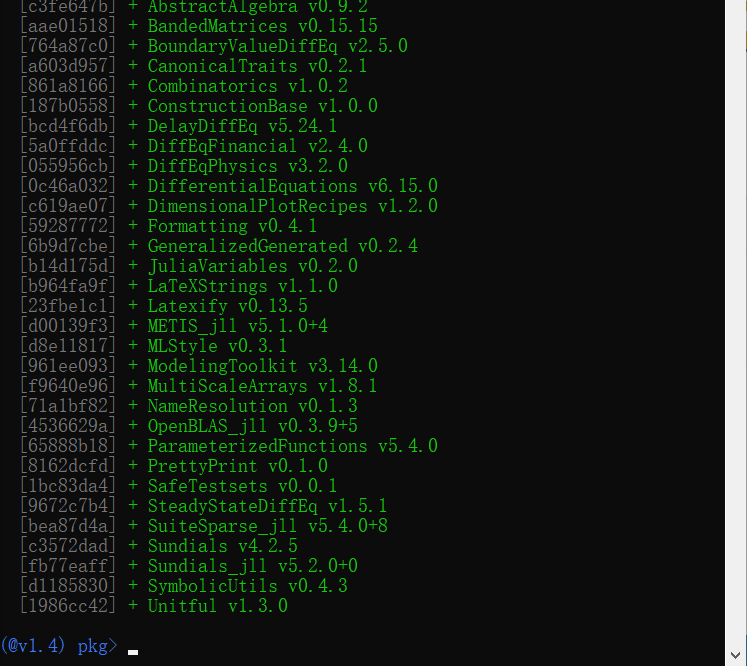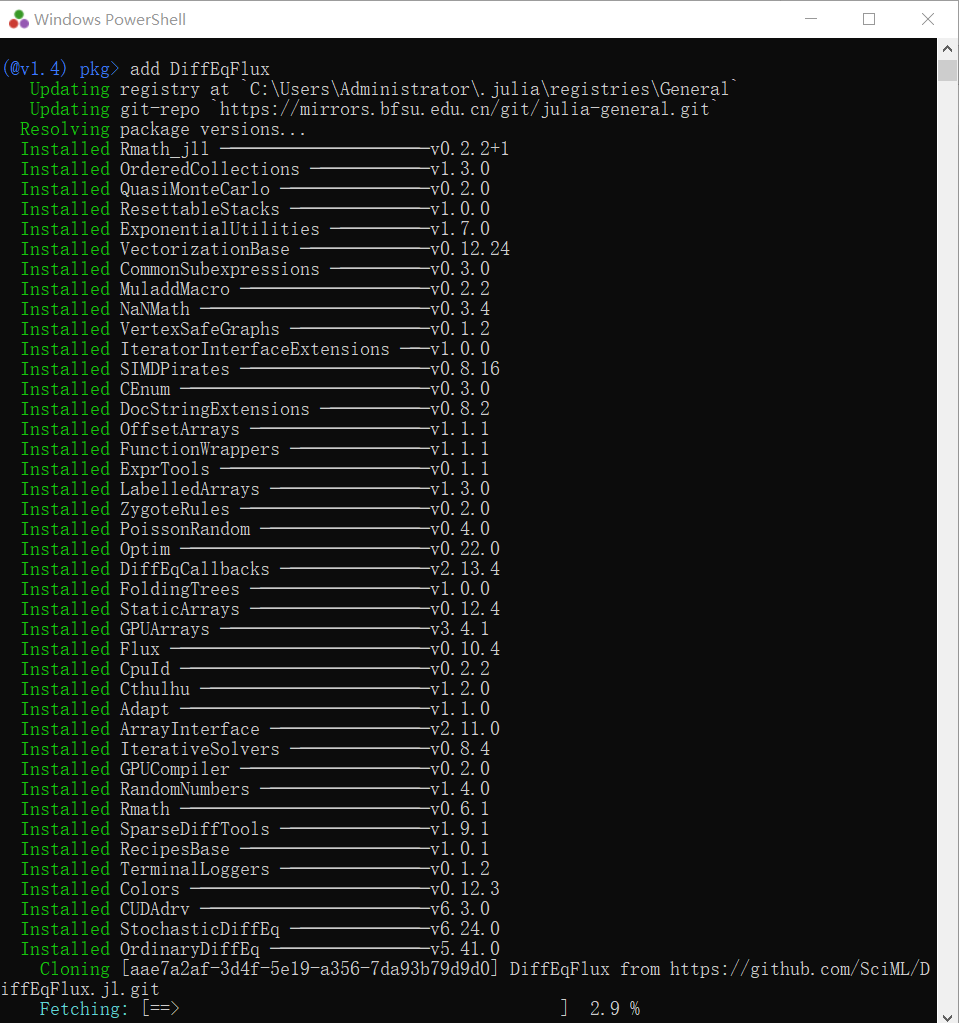Julia的安装
Julia 语言扮演了这样一个角色:它是一门灵活的动态语言,适合用于科学计算和数值计算,并且性能可与传统的静态类型语言媲美。
Julia官网下载安装包
- https://julialang.org/downloads/
- 将安装路径加入path
在vscode中安装Julia插件
- https://code.visualstudio.com/download
- 如果插件没有自动找到Julia的位置而报错,到设置里Julia: Executable Path输入安装路径,要详细到\\bin\\julia.exe。(\用\\)
安装扩展包
安装General 注册表
- 安装了注册表才能安装General 注册表中记录的扩展包
- 打开julia.exe(或者在vscode中按F1,输入Julia: start REPL),按],出现
(@v1.4) pkg> - 输入
registry add https://mirrors.bfsu.edu.cn/git/julia-general.git(这是使用的BFSU北外镜像站安装,比从原始地址(Github)安装和更新要快一些) - 安装完成

- General 的更新会走对应的镜像,而其他数据的下载则通过官方服务器(Pkg server:https://pkg.julialang.org)
安装DifferentialEquations扩展包
- DifferentialEquations.jl是个解微分方程的扩展包:https://diffeq.sciml.ai/dev/
- 输入
add DifferentialEquations - 安装

- 安装完成

安装DiffEqFlux扩展包
- DiffEqFlux.jl也是个解微分方程的扩展包:https://diffeqflux.sciml.ai/dev/
- 输入
add DuffEqFlux - 安装

- 很长..很久之后…
- 安装完成

其他
如果跑代码的时候还报错说缺啥就补啥,总之扩展包都是在pkg模式下用add …,如果不小心断网又重装,可能导致没完全装好,用build …
Julia的使用
Julia解Lotka-Volterra方程组
$$ \frac{d x}{d t}=\alpha x-\beta x y $$
$$ \frac{d y}{d t}=-\delta y+\gamma x y $$
文件Lotka-Volterra.jl:
using DifferentialEquations, Flux, Optim, DiffEqFlux, DiffEqSensitivity
function lotka_volterra!(du, u, p, t)
x, y = u
α, β, δ, γ = p
du[1] = dx = α*x - β*x*y
du[2] = dy = -δ*y + γ*x*y
end
# Initial condition
u0 = [1.0, 1.0]
# Simulation interval and intermediary points
tspan = (0.0, 10.0)
tsteps = 0.0:0.1:10.0
# LV equation parameter. p = [α, β, δ, γ]
p = [1.5, 1.0, 3.0, 1.0]
# Setup the ODE problem, then solve
prob_ode = ODEProblem(lotka_volterra!, u0, tspan, p)
sol_ode = solve(prob_ode, Tsit5())
# Plot the solution
using Plots
plot(sol_ode)
savefig("LV_ode.svg")可以在vscode或者cmd中输入julia Lotka-Volterra,或者在julia REPL中输入julia> include("Lotka-Volterra.jl")。
Julia解 Lorenz方程组
$$ \frac{d x}{d t}=\sigma(y-x) $$
$$ \frac{d y}{d t}=x(\rho-z)-y $$
$$ \frac{d z}{d t}=x y-\beta z $$
文件Lorenz2.jl:
using DifferentialEquations, Plots
function parameterized_lorenz!(du,u,p,t)
x,y,z = u
σ,ρ,β = p
du[1] = dx = σ*(y-x)
du[2] = dy = x*(ρ-z) - y
du[3] = dz = x*y - β*z
end
u0 = [1.0,0.0,0.0]
tspan = (0.0,100.0)
p = [10.0,28.0,8/3]
prob = ODEProblem(parameterized_lorenz!,u0,tspan,p)
sol = solve(prob)
plot(sol,vars=(1,2,3))
savefig("L2_ode.svg")可以在vscode或者cmd中输入julia Lorenz2,或者在julia REPL中输入julia> include("Lorenz2.jl")。
运行环境为笔记本电脑,win10专业版,64位,CPU: Intel(R) Core(TM) i7-6700HQ CPU @ 2.60GHz,8核,RAM 8G,Julia Version 1.4.2,运行时长大约110s左右。
[Running] julia "e:\Julia\Lorenz2.jl"
[Done] exited with code=0 in 114.155 secondsJulia解二阶常微分方程
$$ \ddot{\theta}+\frac{g}{L} \sin (\theta)=0 $$
# Simple Pendulum Problem
using OrdinaryDiffEq, Plots
#Constants
const g = 9.81
L = 1.0
#Initial Conditions
u₀ = [0,π/2]
tspan = (0.0,6.3)
#Define the problem
function simplependulum(du,u,p,t)
θ = u[1]
dθ = u[2]
du[1] = dθ
du[2] = -(g/L)*sin(θ)
end
#Pass to solvers
prob = ODEProblem(simplependulum, u₀, tspan)
sol = solve(prob,Tsit5())
#Plot
plot(sol,linewidth=2,title ="Simple Pendulum Problem", xaxis = "Time", yaxis = "Height", label = ["\\theta" "d\\theta"])
savefig("2nd-Order.svg")
p = plot(sol,vars = (1,2), xlims = (-9,9), title = "Phase Space Plot", xaxis = "Velocity", yaxis = "Position", leg=false)
function phase_plot(prob, u0, p, tspan=2pi)
_prob = ODEProblem(prob.f,u0,(0.0,tspan))
sol = solve(_prob,Vern9()) # Use Vern9 solver for higher accuracy
plot!(p,sol,vars = (1,2), xlims = nothing, ylims = nothing)
end
for i in -4pi:pi/2:4π
for j in -4pi:pi/2:4π
phase_plot(prob, [j,i], p)
end
end
plot(p,xlims = (-9,9))
savefig("2nd-Order2.svg")[Running] julia "e:\Julia\2nd-Order.jl"
[Done] exited with code=0 in 84.122 secondsJulia解Hénon_Heiles方程组
$$ \frac{d^{2} x}{d t^{2}}=-\frac{\partial V}{\partial x} $$
$$ \frac{d^{2} y}{d t^{2}}=-\frac{\partial V}{\partial y} $$
其中
$$ V(x, y)=\frac{1}{2}\left(x^{2}+y^{2}+2 x^{2} y-\frac{2}{3} y^{3}\right) $$
using OrdinaryDiffEq, Plots
#Setup
initial = [0.,0.1,0.5,0]
tspan = (0,100.)
#Remember, V is the potential of the system and T is the Total Kinetic Energy, thus E will
#the total energy of the system.
V(x,y) = 1//2 * (x^2 + y^2 + 2x^2*y - 2//3 * y^3)
#Define the function
function Hénon_Heiles(du,u,p,t)
x = u[1]
y = u[2]
dx = u[3]
dy = u[4]
du[1] = dx
du[2] = dy
du[3] = -x - 2x*y
du[4] = y^2 - y -x^2
end
#Pass to solvers
prob = ODEProblem(Hénon_Heiles, initial, tspan)
sol = solve(prob, Vern9(), abs_tol=1e-16, rel_tol=1e-16);
# Plot the orbit
plot(sol, vars=(1,2), title = "The orbit of the Hénon-Heiles system", xaxis = "x", yaxis = "y", leg=false)
savefig("HH_ode.svg")[Running] julia "e:\Julia\Hénon-Heiles.jl"
[Done] exited with code=0 in 68.487 seconds以上例子出自:
- https://diffeq.sciml.ai/dev/
- https://diffeqflux.sciml.ai/dev/
- https://tutorials.sciml.ai/html/models/01-classical_physics.html






